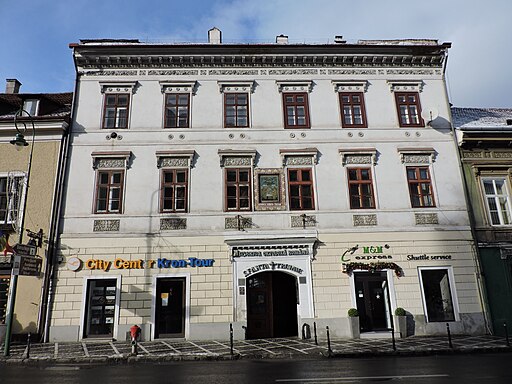Holy Trinity Orthodox Church
Biserica Sfânta Treime
Holy Trinity Orthodox Church
Biserica Sfânta Treime
Address:
Strada George Barițiu 12
Historical Hungarian county:
Brassó
GPS coordinates:
45.6414709885, 25.5875597388
History
The so-called Greek Company (merchant society) was founded in 1678. Its members were long-distance wholesale merchants and entrepreneurs, bound together by a corporative spirit, an identical legal status in the Ottoman and later the Habsburg Empire and a specific culture. They used the Greek language among themselves and were all of the Orthodox faith. Their ethnic and linguistic background was heterogeneous: initially, most of them were Aromanians, but there were also a number of Vlachs from Wallachia and Balkan Slavs (Bulgarians and Serbs). During the 18th century, many of the wealthiest Vlach merchants of Bolgárszeg also joined the company. Most of the Vlachs from Bolgárszeg lost their membership of the Company in 1783 because they did not swear that they were 'Greek' (i.e. from what is now Greece or Macedonia). By the middle of the 19th century, the merchant families of various origins had become linguistically Vlach and clung to Greek only as a sacral language.
After Emperor Joseph II's Patent of Toleration, in 1786, the Company and the non-member Vlach and Greek merchants and butchers who had moved to the town centre after the imperial decree opened the Saxon towns for other nationalities, were granted permission by the town council to build a church for all Orthodox believers. And at the request of Bishop Gedeon Nikitić, Greeks and Vlachs agreed to share the church. The building was consecrated in 1788, but the following year the war between the Companist and non-Companist Vlachs, which would continue for more than a century, began.
After the suppression of the Ipsilantis rebellion in 1821, Greeks from Moldavia and Wallachia fled in large numbers to Brassó, where they became the majority in the parish. They brought in a Greek priest and removed the Vlach worshippers from the church. In 1833, the expelled Vlach built their own chapel on Búzasor. In the meantime, the Company lost significance, and after the suppression of the 1848 Hungarian Revolution, Bishop Andrei Șaguna dismissed the Greek priest and appointed a Vlach in his place. In 1886, a court in Budapest sentenced the parish to the Greeks. Since 1942 the liturgical language of the church has been Romanian.
The oldest of his icons is a Venetian work from 1633. Several of his icons date from the 17th and 18th centuries, others were made in 1851 by the Saxon goldsmith Jekelius. The interior painting is by a painter called Gulimievici from 1859. Its old collection of books and manuscripts was transferred to the Romanian Academy Library in 1931.
{"item":"sight","set":{"sightId":2011,"townId":77,"active":1,"name_LO":"Biserica Sf\u00e2nta Treime","address":"Strada George Bari\u021biu 12","mapdata":"1|929|1845","gps_lat":"45.6414709885","gps_long":"25.5875597388","religion":5,"oldtype":"1","newtype":"1","homepage":"","openinghours":"","muemlekemlink":"","csemadoklink":"","picture":"\u003Ca title=\u0022Dimitris Kamaras from Athens, Greece, CC BY 2.0 <https:\/\/creativecommons.org\/licenses\/by\/2.0>, via Wikimedia Commons\u0022 href=\u0022https:\/\/commons.wikimedia.org\/wiki\/File:Holy_Trinity_church_(Biserica_Sfanta_Treime_din_Cetate),_Brasov_(46424728812).jpg\u0022\u003E\u003Cimg width=\u0022512\u0022 alt=\u0022Holy Trinity church (Biserica Sfanta Treime din Cetate), Brasov (46424728812)\u0022 src=\u0022https:\/\/upload.wikimedia.org\/wikipedia\/commons\/thumb\/e\/e0\/Holy_Trinity_church_%28Biserica_Sfanta_Treime_din_Cetate%29%2C_Brasov_%2846424728812%29.jpg\/512px-Holy_Trinity_church_%28Biserica_Sfanta_Treime_din_Cetate%29%2C_Brasov_%2846424728812%29.jpg\u0022\u003E\u003C\/a\u003E","picture_ref":"\u003Ca href=\u0022https:\/\/commons.wikimedia.org\/wiki\/File:Holy_Trinity_church_(Biserica_Sfanta_Treime_din_Cetate),_Brasov_(46424728812).jpg\u0022\u003EDimitris Kamaras from Athens, Greece\u003C\/a\u003E, \u003Ca href=\u0022https:\/\/creativecommons.org\/licenses\/by\/2.0\u0022\u003ECC BY 2.0\u003C\/a\u003E, via Wikimedia Commons","name":"Holy Trinity Orthodox Church","note":"","history":"The so-called Greek Company (merchant society) was founded in 1678. Its members were long-distance wholesale merchants and entrepreneurs, bound together by a corporative spirit, an identical legal status in the Ottoman and later the Habsburg Empire and a specific culture. They used the Greek language among themselves and were all of the Orthodox faith. Their ethnic and linguistic background was heterogeneous: initially, most of them were Aromanians, but there were also a number of Vlachs from Wallachia and Balkan Slavs (Bulgarians and Serbs). During the 18th century, many of the wealthiest Vlach merchants of Bolg\u00e1rszeg also joined the company. Most of the Vlachs from Bolg\u00e1rszeg lost their membership of the Company in 1783 because they did not swear that they were 'Greek' (i.e. from what is now Greece or Macedonia). By the middle of the 19th century, the merchant families of various origins had become linguistically Vlach and clung to Greek only as a sacral language.@\nAfter Emperor Joseph II's Patent of Toleration, in 1786, the Company and the non-member Vlach and Greek merchants and butchers who had moved to the town centre after the imperial decree opened the Saxon towns for other nationalities, were granted permission by the town council to build a church for all Orthodox believers. And at the request of Bishop Gedeon Nikiti\u0107, Greeks and Vlachs agreed to share the church. The building was consecrated in 1788, but the following year the war between the Companist and non-Companist Vlachs, which would continue for more than a century, began.@\nAfter the suppression of the Ipsilantis rebellion in 1821, Greeks from Moldavia and Wallachia fled in large numbers to Brass\u00f3, where they became the majority in the parish. They brought in a Greek priest and removed the Vlach worshippers from the church. In 1833, the expelled Vlach built their own chapel on B\u00fazasor. In the meantime, the Company lost significance, and after the suppression of the 1848 Hungarian Revolution, Bishop Andrei \u0218aguna dismissed the Greek priest and appointed a Vlach in his place. In 1886, a court in Budapest sentenced the parish to the Greeks. Since 1942 the liturgical language of the church has been Romanian.@\nThe oldest of his icons is a Venetian work from 1633. Several of his icons date from the 17th and 18th centuries, others were made in 1851 by the Saxon goldsmith Jekelius. The interior painting is by a painter called Gulimievici from 1859. Its old collection of books and manuscripts was transferred to the Romanian Academy Library in 1931.\n&\nwikipedia: G\u00f6r\u00f6g templom (Brass\u00f3)|https:\/\/hu.wikipedia.org\/wiki\/G%C3%B6r%C3%B6g_templom_(Brass%C3%B3)\nwelcometoromania.eu: Brass\u00f3, A Szenth\u00e1roms\u00e1g templom|https:\/\/www.welcometoromania.eu\/Brasov\/Brasov_Biserica_Sfanta_Treime_m.htm","town":{"townId":77,"name_HU":"Brass\u00f3","name_LO":"Bra\u0219ov","seolink":"brasso-brasov","oldcounty":40,"country":4}},"language":"en","region":"romania","regionid":4,"offer":[],"gallery":false,"album":false}

